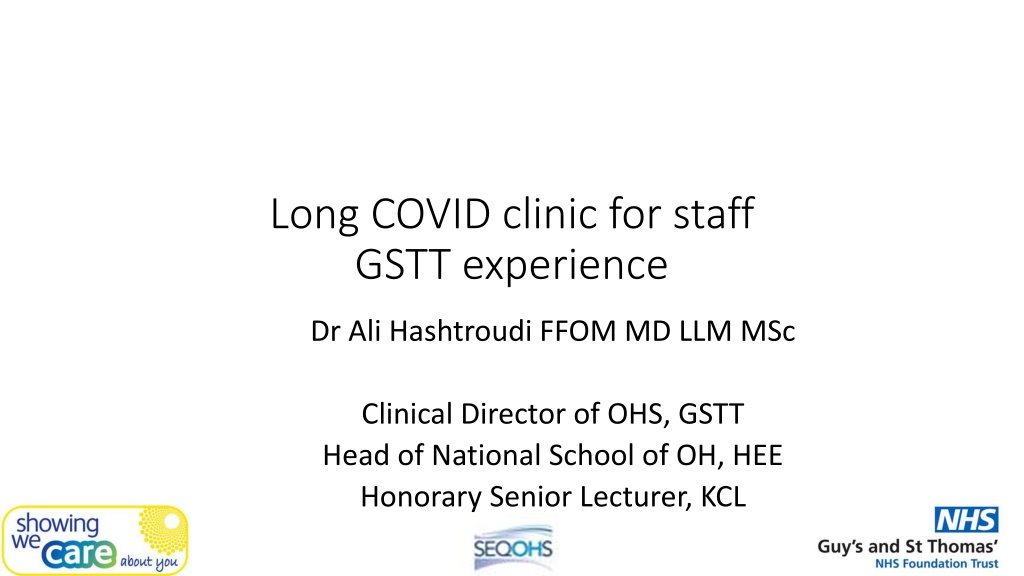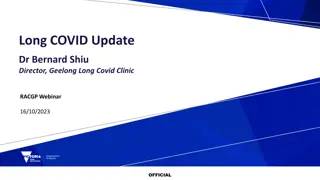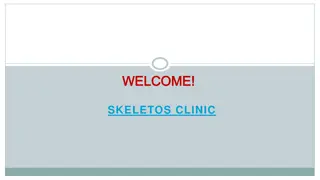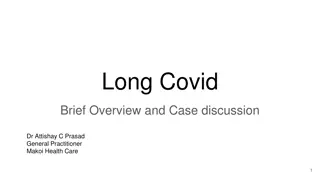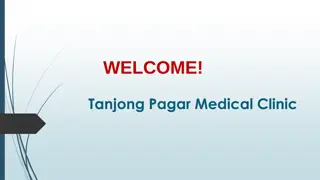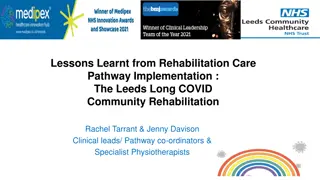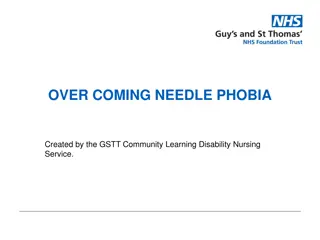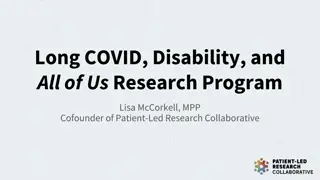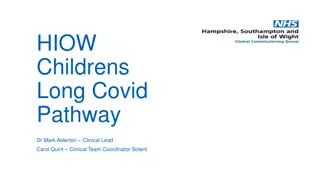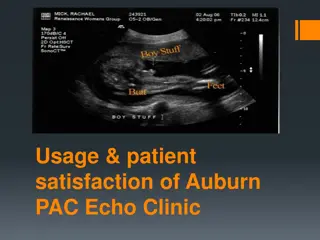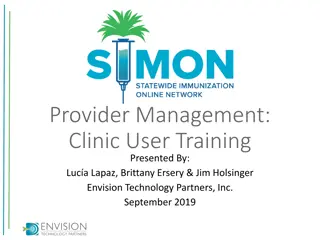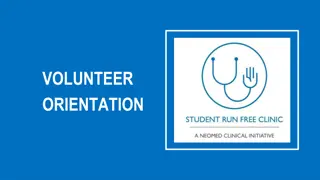Understanding Long COVID Clinic Experience at GSTT with Dr. Ali Hashtroudi
Explore the comprehensive long COVID clinic experience for staff at Guy's and St Thomas' NHS Foundation Trust (GSTT) led by Clinical Director Dr. Ali Hashtroudi. Learn about diagnosis, treatment, and management strategies for persistent COVID symptoms, with a focus on immunity, psychological factors, and epidemiological insights. Discover the OH management, fitness assessments, rehabilitative advice, and referral criteria offered at GSTT since February 2021.
Download Presentation

Please find below an Image/Link to download the presentation.
The content on the website is provided AS IS for your information and personal use only. It may not be sold, licensed, or shared on other websites without obtaining consent from the author. Download presentation by click this link. If you encounter any issues during the download, it is possible that the publisher has removed the file from their server.
E N D
Presentation Transcript
Long COVID clinic for staff GSTT experience Dr Ali Hashtroudi FFOM MD LLM MSc Clinical Director of OHS, GSTT Head of National School of OH, HEE Honorary Senior Lecturer, KCL
What (NOT) to expect Knowledge GSTT Clinic
Knowledge 19 (32) review Salamanna s review 11361 (May 2021), Lopez-Leon 18251 (Aug 2021) So many publication good or bad? Cluster of symptoms Non-specific: fatigue, flu like, brain fog Respiratory, neurology, cardiovascular Mental health
Basic information Epidemiology: 5 to 87% Cause: immune system, psychological, Diagnosis: non-specific symptoms, evidence of COVID Risk factors: women, increasing age, severity / number of initial COVID, comorbidity, obesity, ethnicity Treatment Prognosis
WE KNOW A LOT OH management Fitness to work assessment Rehabilitation
FtW assessment framework Cognitive Physical Ill health Organisation Functions FtW Risks Self Customers Job requirement Physical Colleagues Psychological Cognitive
Overlaps Long COVID Fatigue Aches and pain Depression, anxiety Breathless Other conditions CFS, mental health, MSK problem Common mental health COPD, asthma, CFS
Ill health # loss function Ill health # loss function Illness # unfit Illness # unfit adjustments ~ functions adjustments ~ functions
GSTT experience Started in February 2021 Referral Initially management referral, now self referral too OH triage Red flag: severe hypoxaemia or oxygen desaturation on exercise, signs of severe lung disease, cardiac chest pain OH assessment and rehabilitative advice Referral
Post-COVID syndrome referral decision aid Confirmed or suspected COVID AND More than 4 weeks from symptom onset No Do not refer - reassure and review if symptoms have not improved by 4 weeks Yes Primary symptoms: - Deconditioning/fatigue - Generalised body pain - Localised muscle/joint ache Refer to post-COVID syndrome clinic and send letter to GP What are the current symptoms? Are there any red flags? - Severe hypoxaemia or desaturation on exercise* - Signs of severe lung disease* - Cardiac symptoms including chest pain & tachycardia - Neurological symptoms (pins & needles, weakness or clumsiness) - Gastrointestinal symptoms (abdominal pain, nausea, diarrhoea, weight loss, loss of appetite) +/- concurrent symptoms: - Breathlessness - Cough - Depression &/or anxiety - Cognitive impairment (brain fog, memory, concentration) - Dizziness - Sleep disturbance - Headache - Persistent loss of taste or smell Consider concurrent referral to OH psychology, IAPT or GP for mental health symptoms No Yes Do not refer to post-COVID clinic - depending on severity consider referral to A&E or assessment by GP/specialist *Guidance for assessing respiratory red flags via remote consultation: - Does the patient feel short of breath? Do they have any wheeze? Can they talk in full sentences? - Are they so ill that they can t manage activities of daily living? Has there been any significant worsening in their breathing over the last few days? - Blue lips at rest or on exercise (eg climbing the stairs). - Sitting forwards to breathe more easily (eg tripod position sitting forward and resting on both arms). - Ask them to measure their pulse instruct the patient how to find their pulse. If they are able to, ask them to count the beats out loud and time them over 15 seconds. A normal pulse rate is 60 100 beats per minute. - Ask if they have a pulsoximeter.
START: Are there any Red Flags, excluding Breathlessness? Are there any Primary symptoms >4 weeks post infection? YES NO Is there breathlessness? NO YES YES NO Get full history and d/w OHP Complete Referral If workplace adjustments required book with OHPO as well I or II III / IV NHYA Class Notes: Always ask about all possible red flags
Clinic Run by OH physiotherapy Input from OT Referral to OH psychology F2F, remote Gradual return to activity Signposting
Basis stats to date 50 referral 25% DNA Majority single appointment Five 2x appointment One 3x appointment
Age Mean age = 49 30'S 40'S 50'S 60'S
Occupational group Staff professional Groups 9% 9% 27% 14% 23% 18% N&M Dr AHP Admin Aux. Manage
Symptoms Primary Presenting Symptoms Secondary Symptoms 9% 11% 11% 18% 50% 28% 73% Breathlessness Cognitive impairment Fatigue MSK Pain Fatigue+MSK Neurological Symptoms ENT
Lesson: SET THE EXPECTATION
Staff side involvement Clinic is part of health and wellbeing offer Showing we care about you HWB strategy and governance Initiative leads Forum Executive People Exec Board
Prevention the best strategy Individual and environmental risk assessment and risk management
Hierarchy control Vaccination Lateral flow test
Thanks Aliasad.hashtroudi@gstt.nhs.uk Ali.hashtroudi@hee.nhs.uk Aliasad.Hashtroudi@nhs.net
